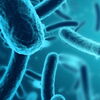2018-12-31
- “Microbes are king of the world. If human beings ceased to exist, microbes wouldn’t even notice [except those in the human microbiome], but if microbes ceased to exist today, human beings would cease to exist tomorrow.”
- 2018-12-21 - UIUC Biochemistry Assistant Professor Hong Jin has been selected as an LAS Helen Corley Petit Scholar.
- 2018-12-17 - Our fall issue of the MCB magazine focuses on the diverse ways in which microbes affect our health.
- 2018-12-12 - The Anakk lab has investigated the metabolic repercussions of deleting the scaffolding protein IQGAP1. These findings were published in a paper entitled "Identification of IQ motif-containing GTPase Activating Protein 1 as a regulator of long-term ketosis" in JCI Insight.
- 2018-10-14 - Mice with epilepsy have altered patterns of neuron activity in the portion of the brain that controls the reproductive endocrine system, University of Illinois researchers report in a new study.
- 2018-10-03 - In work published in Infection and Immunity, graduate student Jessica Kelliher, from the laboratory of Dr. Thomas Kehl-Fie, investigated how the superbug Staphylococcus aureus regulates the acquisition of phosphate.
- 2018-09-28 - The Prasanth lab has recently published a paper in Nucleic Acids Research titled “MIR100 host gene-encoded lncRNAs regulate cell cycle by modulating the interaction between HuR and its target mRNAs.”
- 2018-09-27 - New research conducted by biochemists at the University of Illinois has determined how damaged liver cells repair and restore themselves through a signal to return to an early stage of postnatal organ development. The findings are reported in the journal Nature Structural & Molecular Biology.
- 2018-09-18 - Using a suite of techniques both common and new to geology and biology, researchers, from left, M.D./Ph.D. student Jessica Saw, geologist and microbiologist Bruce Fouke, microscopy expert and plant biologist Mayandi Sivaguru and their colleagues made new discoveries about how kidney stones repeatedly grow and dissolve as they form inside the kidney.
- 2018-09-08 - Each year, at least 23,000 people die from infections caused by antibiotic resistant bacteria in the U.S., according to the Centers for Disease Control and Prevention. Using computer modeling, researchers from the University of Illinois at Urbana-Champaign and Sandia National Laboratories are helping to develop the means to prevent some of those deaths.
- 2018-08-30 - The Zhang and Pan labs recently published a joint paper in Nanoscale titled “Carbon dots with induced surface oxidation permits imaging at single-particle level for intracellular studies.”
- 2018-08-28 - In a new paper in the Journal of Cell Biology, researchers from the University of Illinois at Urbana-Champaign describe a new technique that can measure the position of every single gene in the nucleus to build a 3D picture of the genome’s organization.
- 2018-08-24 - Molecular and integrative physiology professor Hee Jung Chung, postdoctoral fellow Eung Chang Kim, and their colleagues discovered that abnormal expression and phosphoinositide regulation of KCNQ/Kv7 potassium channels underlie neuronal hyperexcitability and injury in early-onset epileptic encephalopathy characterized by drug-resistant seizures and severe psychomotor retardation.
- 2018-07-26 - Monica has been recognized as an Outstanding Scholar by the Hispanic Scholarship Fund and as a Chester and Nadine Houston graduate fellow.
- 2018-07-24 - The College of Liberal Arts & Sciences has announced the recipients of its 2018 annual alumni awards: Anne Carpenter, (PhD,'03 CSB) and Joanne Chory, (MS, '80 MICRO).














